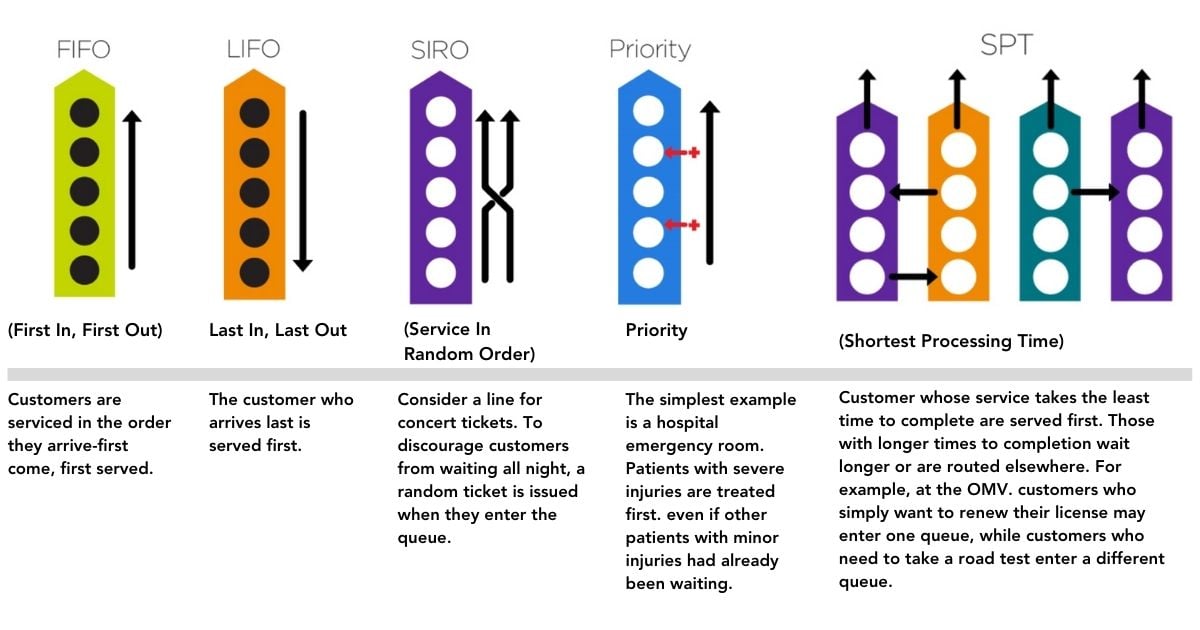No one likes to wait. But whether your business is in retail, healthcare, education, or something else entirely, your customers are waiting on you—to check them out, to solve their problem, or receive whatever service your business provides.
You can’t eliminate waiting altogether, but you can reduce wait times, keep your lobby calm and organized, and make waiting much more pleasant—for both your customers and your staff. You can do that with effective queue management.
Table of Contents:
1. What is Queue Management?
2. Queue Management and Perceived Wait Time
3. What is a Queue Management System?
4. Digital Queue Management Systems
5. How a Management System Benefits a Business
6. Components of an Effective Queue Management System
7. Is a Queue Management System Right for You?
8. How to Choose a Queue Management System
What is Queue Management?
Queue management can be very technical—incorporating queuing theory, waiting line models, queue discipline, service channels, and more. But in real-world, practical terms, queue management is a set of processes that helps you organize and control your customer’s waiting experience.
Queue Management and Perceived Wait Time
The goal of queue management is to minimize customer wait times—not only the amount of time they’re actually waiting but also the amount of time they feel like they’re waiting. This is called perceived wait time and is even more important than the actual wait time.
People generally feel like they’ve been waiting in line for longer than they actually have been. When a line is long, people assume they’ll have a long wait, even if that line is moving fairly quickly. If your lobby or waiting area is crowded or disorganized, it has the same negative effect.
If your customers’ perceived wait time is too long, those who have the option may leave. Customers who don’t have the option to leave may become frustrated, taking a toll on your staff and customer satisfaction. Either way, prolonged wait times and inefficient queuing present problems for your business—problems that can be solved through queue management.
What is a Queue Management System?
Even if you’re not familiar with queue management system (QMS), you’ve certainly encountered them in lots of commonplaces. Queue management systems take many different forms, including:
- Physical barriers (like the retractable belts at airport security)
- Sign-in sheets (common at doctor’s offices)
- Taking tickets to determine the order of service (at the DMV, for example)
- A person (an usher who scans your ticket at a theatre and shows you to your seat)
Digital Queue Management Systems
Today, when we talk about queue management solutions, we are often referring to digital queue management systems—software and automated tools that streamline your customer queuing experience instead of the manual ones mentioned above. Digital queue management systems can include or be combined with some or all of the following features:
- Appointment scheduling: Customers can schedule appointments online and receive automated reminders.
- Self-service customer check-in: Customers check in on their own when they arrive, most often via a kiosk or their own mobile device.
- Virtual queuing: Customers check-in remotely, before they arrive at your location. This enables them to wait in other areas aside from your lobby or waiting room.
- Automated wait time alerts: Customers receive an initial wait time upon check-in and receive updates via text message, an app, or even screens in your waiting area.
- Capacity control: Customer entrance and exit data are tracked to determine occupancy levels. If the service area becomes too crowded, wait times increase accordingly, and customers are notified.
Keep in mind that there are many variations within these basic features. Some queue management systems are simple, while others are much more complex.
How a Queue Management System Benefits Your Business
Today, the customer experience is everything. When customers see long lines and an overcrowded lobby—perhaps even noticing the frustration of other customers—it spells trouble for your business:
- Revenue decreases as customers seek out your competition.
- Staff become stressed, negatively affecting morale and engagement.
- Operational costs increase due to impaired business operations
In contrast, when customers wait less—or feel like they are when that’s not possible—you will:
- Improve customer satisfaction: A better customer experience increases loyalty, retention rates, and positive word of mouth advertising—and that means more revenue.
- Make better decisions, faster: Real-time data gives you the information you need to make quick decisions according to what’s happening in your business, right now.
- Increase staff morale: Fewer frustrated, tired customers mean happier staff. This leads to improved productivity and lower turnover costs.
- Enhance health and safety: Crowded lobbies are a thing of the past. When customers can easily keep their distance from others, it shows them that their health and wellbeing are a priority for you.
- Facilitate long-term planning: Robust analytics allow you to spot trends sooner and adjust your strategies accordingly.
- Better allocate resources: Insight into your customer journey ensures you get the right number of staff in the right places, at the right times.
There are many reasons why a queue management system can benefit your business, but they all come down to one thing: A queue management system is an investment in your business’s bottom line.
Components of an Effective Queue Management System
Queue management systems are versatile—they typically offer multiple tools that work together to accomplish your organization’s goals. Depending on your needs, your organization may benefit from all of these features, or just a few.
Basic Queue Management
For some businesses, basic queue management is all that’s necessary. Key features of a basic queue management system include:
- Self-service check-in: Queue management begins when a customer joins the queue. Options include kiosks, mobile devices, and more.
- Customer routing: Based on a pre-determined set of questions, customers are directed to a specific queue or location.
- Automated wait time alerts: Customers receive regular updates on their place in line via their mobile phone or lobby screens.
- Data and reports: Gain valuable insights you can use to improve your customer experience. Queue management systems measure and analyze a variety of KPIs like footfall, wait times, staff productivity, and much more.
In addition to these basic functionalities, some queue management systems include more robust features.
Appointment Scheduling
Appointment scheduling is the foundation of queue management system. Efficient scheduling helps ensure the orderly arrival of customers. Overschedule, and you’ll soon fall behind, leading to increased wait times and unhappy customers. Under schedule, and you’re leaving money on the table.
Today’s customers want—and even expect—online appointment scheduling.
Online scheduling is something that many businesses add to their repertoire—after all, there will always be customers who prefer to book via phone or in person. The important thing is that you’re providing customers with options. If your business also serves walk-in customers, a queue management system can integrate scheduled appointments with walk-ins.
Customers appreciate the ability to book directly from their devices and schedule appointments at their convenience (during off-hours, for example). When it’s fast and easy to make appointments, your schedule stays full.
But it’s not just convenience that matters. No matter what line of business you’re in, the most important customers are the ones who are right in front of you. Online appointment scheduling reduces unnecessary phone calls and distractions, freeing your staff to focus their efforts on serving customers in person.
Automated Reminders
No-shows and last-minute cancelations siphon money from your business.
Automated appointment confirmations and reminders at pre-determined intervals will reduce your no-show rates and late cancellations. You can also offer customers the opportunity to reschedule to a time that better fits their schedule. A queue management system can easily backfill canceled appointments with wait-listed customers, or adjust for increased walk-in traffic.
While a personal reminder call may still be the right choice for some customers, others aren’t able—or don’t want to—to take calls during the workday. Queue management systems offer multiple modalities that allow you to tailor your reminders to each customer or customer population. Modalities may include phone calls, text messages, emails, and app notifications.
Virtual Queuing
Gone are the days of getting in line and staying line, inching forward with no end in sight. Virtual queuing allows customers to wait where it’s convenient for them. It prevents lobby congestion and signals to customers that you value their time.
Instead of checking in upon arrival, customers check-in before they arrive (via a computer or mobile device), reserving their place in line. They can wait in a location of their choice. It could be your lobby, but could also be their car, outdoors, in a nearby café, or any number of places. Customers receive automated updates to ensure they’re ready when you are.
For multi-location businesses (like a chain of auto service centers, for example), customers can view wait times at different locations, choosing what’s most convenient for them. In addition to saving the customer time, this helps keep customer flow even between locations.
Lobby Management
Today, queue management isn’t just about efficiency or the customer experience—it’s also about safety, and will likely continue for a long time to come. Yes, a calm and relaxed waiting environment goes a long way to improve your customer satisfaction and staff morale. But it also expresses to your customers that you value cleanliness along with their health and safety.
Queue management solutions such as appointment scheduling, virtual queuing, and automated updates work together to accommodate social distancing along with more efficient customer flow. Queue management systems will also help you identify—and eliminate—bottlenecks and other trouble spots that lead to gathering and crowding.
Digital signage is another aspect of lobby management that some queue management systems incorporate. Customers experience shorter perceived wait times when they can focus on something besides their wait. Digital signage can not only display wait time updates, queuing information, and safety reminders, but can also entertain customers while they wait.
Is a Queue Management System Right for You?
Most businesses can benefit from a queue management system. Therefore, it’s more useful to think in terms of what level of functionality is right for your business.
Assess your current workflow to determine what’s working, what isn’t, and what you’d like the queue management system to do. Here are some questions to help you get started.
How many steps does it take for a customer to receive full service?
Think about the types of services you offer, and what steps the service process(es) consists of from start to finish. For some services, the customer receives full service in one step. In others, there are many steps. For example, returning an item to a retail store versus undergoing surgery at a hospital.
What is your customer population?
If you use appointments or reservations, you have a limited customer population. A salon, for example, has a set number of chairs and can accept a set number of appointments each day.
Many businesses have unlimited customer populations. There’s no limit to the number of customers who can walk into a grocery store. Other businesses have a combination—they accept appointments (which are limited) and walk-ins (which are not).
How and when do your customers arrive?
In some businesses, customers arrive at regular intervals. More common are random arrivals, where there is no set, regular time period between the arrival of one customer and the next.
The distribution of customer arrivals may change depending on certain times of day, days of the week, or even times of the year. For example, customer arrivals at a community college registration office are highly dependent on the time of year. At a restaurant, the time of day makes a significant difference. To take it one step further, a restaurant located in a mall or airport will have a different arrival pattern than one in a standalone location.
What type of queue fits your business?
There are several different types of queues, each with a different order of service for customers:

- FIFO (First In, First Out): Customers are serviced in the order they arrive—first come, first served. Therefore, the customer who has been waiting for the longest is served first.
- LIFO (Last In, First Out): The customer who arrives last is served first. Think about a line to enter an elevator. The person in the front of the line enters first, waiting in the rear of the elevator. The last person to enter is positioned in the front of the elevator. They exit first, while the person who entered first, exits last.
- SIRO (Service in Random Order): Consider a line for concert tickets. To discourage customers from waiting all night, they receive a random ticket when they enter the queue. That way, their position in line—and their wait—isn’t tied to the order in which they arrived.
- Priority: The simplest example is a hospital emergency room. Patients with severe injuries are treated first, even if other patients with minor injuries had already been waiting.
- SPT (shortest processing time): Customer whose service takes the least time to complete are served first. Those with longer times to completion wait longer or are routed elsewhere. For example, at the DMV, customers who simply want to renew their license may enter one queue, while customers who need to take a road test enter a different queue.
Average waiting times will be different depending on the type of queue your business uses, so efficient management of those queues will require different strategies.
How to Choose a Queue Management System
There’s no downside to implementing digital queue management in your business, but each queue management system does have its own pros and cons. If you do decide that a queue management system is right for your business, you’ll have plenty of options. Here are a few considerations that will help you narrow down the queue management system that’s right for your business.
Industry
A retail business has different queue management needs than a healthcare facility or educational institution. Your queue management vendor should have a wealth of experience in your particular industry. A trustworthy vendor will be upfront about their experience with different types of businesses.
Customization
Systems will offer varying levels of customization, from a one-size-fits-all approach to a turnkey system custom-designed for your business. This doesn’t just include the system’s features, but also the look. Any customer-facing system should be compatible with your brand identity.
You may also want a system that can grow and adapt to changes in your business.
Budget
A queue management system will pay dividends over the long term, and the right system will help you recoup much more than what you spend. But not everyone has an unlimited budget, and queue management systems can be expensive. They range from simple to complex, and of course, the initial cost of the system increases accordingly.
If you’d like a more robust system but have a limited budget, look for solutions that let you start with a basic system, and add features as your budget allows.
IT Infrastructure
Will you need to invest in hardware to support a queue management system? Some are cloud-based, while others require more IT infrastructure.
Integration
Do you need your queue management system to integrate with software you already use (like a CMS, or electronic health record)?
User experience
Some queue management systems require more training than others—other systems have less of a learning curve. Do you have the time and the bandwidth to properly train your staff?
A queue management system helps you optimize each step of your customer journey. By organizing and managing your business's queues, you can eliminate customer wait time when possible, and make waiting far less painful for customers when instant service is not an option. Creating the best customer experience can be simple and intuitive with a queue management system that fits your business.
Conclusion
Do you need your queue management system to integrate with software you already use (like a CMS, or electronic health record)?





